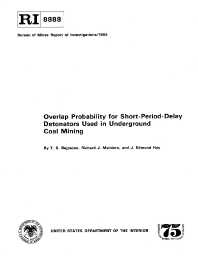Mining Publication: Overlap Probability for Short-Period-Delay Detonators Used in Underground Coal Mining
Original creation date: January 1985
The Bureau of Mines investigated coal-mine-type short-delay electric detonators marketed by three domestic manufacturers to determine the accuracy of delays and the probability of overlap between adjacent delay periods. The Winzer index was computed and compared with the probability of overlap. A close agreement between the winzer criterion and overlap probability was demonstrated. A permissible blasting unit capable of delivering a maximum firing energy of 4.0 J and a digital oscilloscope were used to measure the delay time with an accuracy of plus or minus 0.25 Ms. Another oscilloscope and a pulse transformer were used to record firing current. Experimental data indicated negligible overlap probability in detonators of shorter delay periods: periods 1 to 4, which correspond to 25 to 250 ms. However, a significant probability of overlap was detected in some detonators of longer delay periods: periods 5 to 9, which correspond to 300 to 500 ms.
Authors: TS Bajpayee, RJ Mainiero, JE Hay
Report of Investigations - January 1985
NIOSHTIC2 Number: 10004523
Pittsburgh, PA: U.S. Department of the Interior, Bureau of Mines, RI 8888, 1985 Jan; :1-18
See Also
- Coal Dust Explosibility Meter Evaluation and Recommendations for Application
- Progress Toward Improved Engineering of Seals and Sealed Areas of Coal Mines
- Refuge Alternatives in Underground Coal Mines
- Safe and Economical Inerting of Sealed Mine Areas
- SPONCOM - A Computer Program for the Prediction of the Spontaneous Combustion Potential of an Underground Coal Mine
- Technology News 535 - NIOSH Releases New Educational Video: Escape from Farmington No. 9: An Oral History
- Technology News 545 - NIOSH Updates Spontaneous Combustion Assessment Software
- Ultra-Low Frequency Through-the-Earth Communication Technology
- Wireless Mesh Mine Communication System
- Work Sampling Applied to a Human Factors Analysis of Mine Worker Positioning
- Content source: National Institute for Occupational Safety and Health, Mining Program


 ShareCompartir
ShareCompartir
